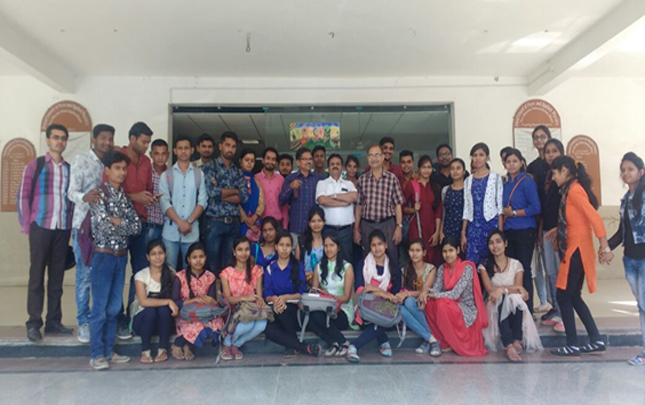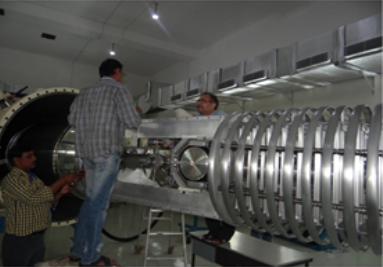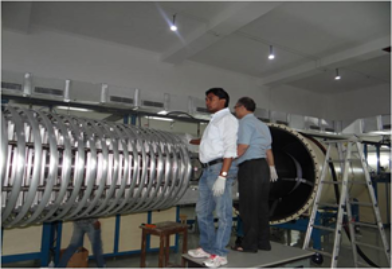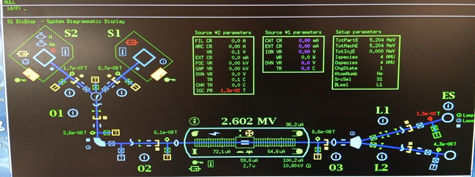NAAC- 2023
| Document | Uploaded On | ||
|---|---|---|---|
| 4. Quality Indicator Framework (QIF) | |||
| Criteria VII Institutional Values and Best Practices | |||
| Key Indicator | 7.1 Institutional Values and Social Responsibilities | ||
| 7.1.1 | Measures initiated by the Institution for the promotion of gender equity during the last five years. Describe the gender equity & sensitization in curricular and co-curricular activities, facilities for women on campus etc., within 500 words Provide Web link to: • Annual gender sensitization action plan • Specific facilities provided for women in terms of: a. Safety and security b. Counseling c. Common Rooms d. Day care centre for children of the staff e. Any other relevant information |
||
|
University is very sensitive to curb gender discrimination and have implemented policy to have zero tolerance in the matter of gender sensitization. There is no case of gender discrimination reported in this period. All schemes of Government of India / State government etc. for promoting girl students educational endeavours are implemented and their outcome are taken care. The university eco-system and code of conduct effective on stake holders ensures respectful behaviour towards women employees and girl students on the campus.
University is ensuring equal concern for girls and boys in all curricular, co-curricular and extracurricular activities and care has been taken to provide level playing field for all. The university conducts UGC / CSIR / NET coaching classes, remedial coaching classes for students of OBC-NCL, PWD, SC, ST, students belonging to minority community or other students who need academic assistance regardless of gender.
The university has Psychological Counseling cell to help students, faculties and officers to stay mentally well. (Website link: Committee Details | Guru Ghasidas Vishwavidyalaya, Bilaspur (C.G.) (ggu.ac.in))
The university has Common rooms in almost all the departments to give female students a place to relax and to have informal discussions in available free time. For safety of female students and staff, the classrooms, corridors and campus main roads are equipped with CCTV cameras. Campus-wide road side CCTV cameras are monitored at a Central Control room established in Central library building.
The university celebrates International women’s day with full enthusiasm.
The women study center of the university has been very active to provide platform for deliberations and discussion and organizes various activities throughout the year. The effort of University in promotion of gender equity is evident from the number of Boys and Girls joining various programs in this academic session. Web Link / Supporting Documents : 1. Annual gender sensitization action plan 2. Specific facilities provided for women |
01.04.2023 | ||
| 7.1.2 | The Institution has facilities for alternate sources of energy and energy conservation measures 1. Solar energy 2. Biogas plant 3. Wheeling to the Grid 4. Sensor-based energy conservation 5. Use of LED bulbs/ power efficient equipment Options: A. Any 4 or all of the above B. Any3 of the above C. Any2 of the above D. Any1of the above E. None of the above (Opt any one) Upload: • Geo-tagged Photographs • Any other relevant information |
||
|
Response: A. Any 4 or all of the above • Uploaded Suppotring Document : 7.1.2 • Uploaded Data Template : 7.1.2 |
01.04.2023 12.04.2023 |
||
| 7.1.3 | Describe the facilities in the Institution for the management of the following types of degradable and non-degradable waste (within 500 words) • Solid waste management • Liquid waste management • Biomedical waste management • E-waste management • Waste recycling system • Hazardous chemicals and radioactive waste management Provide web link to • Relevant documents like agreements/MoUs with Government and other approved agencies • Geo-tagged photographs of the facilities • Any other relevant information |
||
|
The university has placed blue & green dustbins at different common places in the campus to collect degradable & non-degradable waste separately
The waste coming from offices and residential areas was earlier collected by the Bilaspur Municipal Corporation for proper disposal outside the campus. But due to some issues, the waste (segregated into bio degradable and solid waste) are now collected by the sweeping staff. The solid waste is accumulated in the trench from where it is transported for proper disposal outside the campus (in a place identified by the municipal Corporation).
The bio-degradable waste accumulated from the campus are used to prepare organic manure which used in the university nursery for seedlings production etc.
The liquid wastes coming from the old buildings (offices, hostels and teaching departments) are disposed off either through septic tank or soak pits connected to the buildings. Two new Sewerage Treatment Plants (STP) have been constructed in the Campus. One behind the Education building connected with two buildings (Arts & Social Work and Education deptt building). The two new girl’s hostel in the campus are connected to the second STP constructed behind new girls hostel. The Third STP is under construction behind CSIT building and will be connected to three buildings (CSIT, Law and Commerce).
The recycled water flowing out of these STP's are presently delivered on the open land for absorption. In future the university has planned to use this recycled water for garden and wash areas.
Also, all the upcoming buildings in the campus have provision of Sewerage Treatment Plant (STP) in its architectural design plan and work order for the proper disposal of liquid wastes.
High end systems and electronic gadgets are repaired and used for low end semesters as far as possible. All outdated Electrical/Electronic gadgets, instruments etc. are collected, accumulated at a central store for its disposal through E-waste auction. University also procures new instruments, batteries etc. as replacement of existing ones through buyback policy.
Hazardous chemicals & radioactive waste management: The University is having a national centre for acceleration based research and runs the three million electron volt (3 MeV) machine with the permission from Atomic Energy Regulatory Board (AERB). The radiation safety officer and the safety committee takes care of maintaining & monitoring all the safety provisions as prescribed by AERB. All radioactive sources and irradiated materials that may have any activity are kept in the cold room as per the protocol. Neutron, Gamma ray & X-ray detectors are placed in the centre and radiation badges are used by the research workers which are periodically sent for Dose report to BARC as per the protocols.
• Uploaded Suppotring Document : 7.1.3 |
01.04.2023 |
||
| 7.1.4 | Water conservation facilities available in the Institution: 1. Rainwater harvesting 2. Borewell /Open well recharge 3. Construction of tanks and bunds 4. Wastewater recycling 5. Maintenance of water bodies and distribution system in the campus Options: A. Any 4 or all of the above B. Any3 of the above C. Any2 of the above D. Any1of the above E. None of the above (Opt any one) Upload: • Geo-tagged photographs / videos of the facilities • Any other relevant information |
||
| Response: A. Any 4 or all of the above • Uploaded Suppotring Document : 7.1.4 • Uploaded Data Template : 7.1.4 |
01.04.2023 12.04.2023 | ||
| 7.1.5 | Green campus initiatives 7.1.5.1. The institutional initiatives for greening the campus are as follows: 1. Restricted entry of automobiles 2. Use of Bicycles/ Battery powered vehicles 3. Pedestrian Friendly pathways 4. Ban on use of Plastic 5. landscaping with trees and plants Options: A. Any 4 or all of the above B. Any3 of the above C. Any2 of the above D. Any1of the above E. None of the above (Opt any one) Upload • Geo-tagged photos / videos of the facilities • Various policy documents / decisions circulated for implementation • Any other relevant documents |
||
|
Response: A. Any 4 or all of the above • Uploaded Suppotring Document : 7.1.5 |
01.04.2023 |
||
| 7.1.6 | Quality audits on environment and energy are regularly undertaken by the institution 7.1.6.1.The institutional environment and energy initiatives are confirmed through the following 1.Green audit 2. Energy audit 3.Environmental audit 4.Clean and green campus recognitions/awards 5. Beyond the campus environmental promotional activities Options: A. Any 4 or all of the above B. Any3 of the above C. Any2 of the above D. Any1of the above E. None of the above (Opt any one) Upload: • Reports on environment and energy audits submitted by the auditing agency • Certification by the auditing agency • Certificates of any awards received • Any other relevant information |
||
|
Response: A. Any 4 or all of the above • Suppotring Document uploaded : 7.1.6 • Uploaded Data Template : 7.1.6 |
01.04.2023 12.04.2023 |
||
| 7.1.7 | The Institution has friendly, barrier free environment 1. Built environment with ramps/lifts for easy access to classrooms. 2. Divyangjan friendly washrooms 3. Signage including tactile path, lights, display boards and signposts 4. Assistive technology and facilities for Divyangjan accessible website, screen-reading software, mechanized equipment 5. Provision for enquiry and information : Human assistance, reader, scribe, soft copies of reading material, screen reading, font enlargement etc., Options: A. Any 4 or all of the above B. Any3 of the above C. Any2 of the above D. Any1of the above E. None of the above (Opt any one) Upload: • Geotagged photographs / videos of the facilities • Policy documents and information brochures on the support to be provided • Details of the Software procured for providing the assistance • Any other relevant information |
||
|
Response: A. Any 4 or more of the above • Uploaded Suppotring Document : 7.1.7 |
01.04.2023 |
||
| 7.1.8 | Describe the Institutional efforts/initiatives in providing an inclusive environment i.e., tolerance and harmony towards cultural, regional, linguistic, communal, socio-economic and such other diversities (within 500 words). Provide Web link to: • Supporting documents on the information provided (as reflected in the administrative and academic activities of the Institution) • Any other relevant information. |
||
|
1. The University has established Anti-Discrimination Cell for effectively controlling any discrimination based on religion, caste, creed, gender etc. against the students, faculty and staff in the campus. The UGC regulation 2015 has been adopted for prevention/prohibition of sexual harassment to the women employees and students and Internal Complaint Committee is constituted as per its guidelines for the effective re-dress-al of grievances.
2. Under "Ek Bharat Shreshtha Bharat" program, university along with the University of Saurastra organizes various events and meets including visit of/by the students and faculties of the universities to promote cultural and regional diversity.
3. The Equal opportunity cell provides facility of free coaching to students belonging to SC/ST communities and others needing assistance in their academics as an effort to support socio-economic diversity of the tribal state.
4. University's musical band-"Tarang", University theatre & Nukkad play group -"Urchins", University's dance group -"Äbhinartan" and student's magazine – "Udaan" provides an environment to inculcate inter-personnel communication and writing skills among students providing an inclusive environment towards cultural, regional, linguistic, communal and other diversities. However the above activities have been minimal during COVID pandemic situation.
5. UGC sponsored Endangered language centre has been established in the campus to preserve & propagate various dialects & culture of ethnic group.
• Uploaded Suppotring Document : 7.1.8 |
01.04.2023 |
||
| 7.1.9 | Sensitization of students and employees of the Institution to the constitutional obligations: values, rights, duties and responsibilities of citizens
Describe the various activities in the Institution for inculcating values for being responsible citizens as reflected in the Constitution of India within 500 words.
Provide weblink to : • Details of activities that inculcate values necessary to nurture students to become responsible citizens • Any other relevant information |
||
| Guru Ghasidas Vishwavidyalaya, while understanding its role towards nation, undertakes different initiatives in organizing various events and programs and thereby sensitizes the students and employees to the constitutional obligation: values, rights, duties and responsibilities of the citizens. The Vishwavidyalaya provides both the Students and Employees a democratic environment. It takes pride of raising up successful leaders among the students by conducting the Student Council election every year. Election is also held for choosing leaders from among Employee. Both the Students and Employee enjoy freedom of association; protection of their common interest is sought, perused and defended through the collective action within the bounds of rules and regulation of the Vishwavidyalaya. In order to develop an open-minded attitude, essential for becoming conscious citizen, students are encouraged to questions, debate and dialogue among themselves and with the faculty. The Department of Law offer a course paper “Constitutional Law” as a generic elective course to be chosen by any other department for their students. The other departments of the university have also framed a course on “Constitution of India”. Offering these courses, though a small step, are helpful in inculcating constitutional obligations among the students. In Policies of the Vishwavidyalaya reflects the rule of law. An intelligently drafted Code of Conducts for being followed by both students and employees, in-fact, negates the rule of power, status, etc. As democracy and rule of law can be established and achieved by informed citizenry, the Vishwavidyalaya respects the sanctity and the necessity of having a separate RTI Cell having objectives of bringing increased transparency and accountability in administration. Legal aid to the poor and weak is necessary for the preservation of rule of law which is necessary for the existence of the orderly society. In this context, the Vishwavidyalaya feels pride in renovating its Legal Aid Clinic whose functions are to create legal awareness and to assist the poor who is denied inequality of opportunity to seek justice. The Vishwavidyalaya is not insensitive to its responsibility towards Environmental Protection, one of its constitutional obligations. Environmental Studies are offered to all graduate students as AECC course. Besides, different departments of Vishwavidyalaya in their own initiatives conduct awareness programs and mobilise their sources including their students in the drive on ban of plastics, cleanliness, Swatch Bharat, etc. This includes hosting of webinars, speech and debate competitions, etc. The Vishwavidyalaya follows all national, international days, birth and death anniversary of legendary persons every year. Among them are Independence Day, Republic Day, Teacher’s Day, Constitution Day, International Human Rights Day, Anti-Terrorism Day, Vigilance Day, World Environment Day, Birth Anniversary of Mahatma Gandhi, Sardar Vallabhbhai Patel, Subhash Chandra Bose, etc. Independence and Republic Day are enthusiastically celebrated every year. Flag hoisting ceremony is organized followed by recitation of the National Anthem. The Vice Chancellor delivers a talk on the importance of freedom and the glory Indian freedom struggle. Different cultural programs and events are performed which aim at highlighting the constitutional spirit of liberty, equality, justice and fraternity. Several plays with themes based on freedom fighters are staged to familiarize stakeholders about their struggle and sacrifice these freedom fighters gave for the nation. Every year on 26th of November, National Constitution Day is celebrated. The students, teaching and non-teaching faculties gather together and reading of the preamble of constitution is administered by the Vice-Chancellor, faculties, Officers. It is then followed by special lecture which has focus on enlightening the students about their rights and duties being the responsible citizens of the country. Speech and Debate Competition is held to mark the occasion. As responsible citizens of the country, students are motivated to take part in various activities of the Vishwavidyalaya. It is a matter of pride that the Vishwavidyalaya has more than eight unit of NSS in its campus, and recently opened NCC Unit in the campus are attracting the students for their participation in Nation Building and National Security. It is a matter of pride that every year on the occasion of Armed Force Flag Day contribution is collected by deduction from salary of the employees, and the amount so collected is deposited in the District Army Welfare Office, Bilaspur, Chhattisgarh. Various departments of the Vishwavidyalaya and NSS units are actively involved in conducting several activities for inculcating values for being responsible citizens. Among them are: Blood Donation Camp; Swatch Bharat Abhiyan; Cleanliness Drive; Plantation, etc. Website link :- DSW | Guru Ghasidas Vishwavidyalaya, Bilaspur (C.G.) (ggu.ac.in) | 01.04.2023 | ||
| 7.1.10 | The Institution has a prescribed code of conduct for students, teachers, administrators and other staff and conducts periodic programmes in this regard. 1. The institutional Code of Conduct principles are displayed on the website 2. There is a committee to monitor adherence to the institutional Code of Conduct principles 3. Institution organizes professional ethics programmes for students, teachers, administrators and other staff 4. Annual awareness programmes on Code of Conduct are organized Options: A. All of the above B. Any3 of the above C. Any2 of the above D. Any1of the above E. None of the above (Opt any one) Upload: • Code of conduct and ethics policy document • Details of the monitoring committee composition and minutes of the committee meeting, number of programmes organized, reports on the various programs etc., in support of the claims. • Any other relevant information |
||
|
Response: A. All of the above • Uploaded Suppotring Document : 7.1.10 • Uploaded Data Template : 7.1.10 |
01.04.2023 12.04.2023 |
||
| 7.1.11 | Institution celebrates / organizes national and international commemorative days, events and festivals Describe the efforts of the Institution in celebrating /organizing national and international commemorative days, events and festivals during the last five years within 500 words Provide weblink to : • Annual report of the celebrations and commemorative events for the last five years • Geo-tagged photographs of some of the events • Any other relevant information |
||
|
University every year celebrates different national and international commemorative days like Swami Vivekanand Jayanti, Birth Anniversary of Netaji Subhash Chandra Bose, National Science Day, International women’s Day, World Forestry Day, Birthday of Dr. B. R. Ambedkar, World No Tobacco Day, World Environment Day, International Yoga Day, Teachers Day, National Sports Day –, etc. University organises various activities and events to celebrate the above days with enthusiasm with the involvement of the stakeholders of the university. However, some of these events were organized online amid COVID – 19 protocols during the COVID period. Website link :- DSW | Guru Ghasidas Vishwavidyalaya, Bilaspur (C.G.) (ggu.ac.in) • Uploaded Suppotring Document : 7.1.11 |
01.04.2023 |
||
| Key Indicator | 7.2 Best Practices | ||
| 7.2.1 | Describe two Best practices successfully implemented by the Institution as per the NAAC format provided in the Manual.
Provide web link to: • Best practices as hosted on the Institutional website • Any other relevant information |
||
| BEST PRACTICE I | 1. Title of the Practices: Sustainability Practices
• Use of Renewable Energy Resources (Solar Energy) • Water Conservation Practices (Rain Water Harvesting System and Water Storage Tanks-Ponds) • Plantation Drives • Nature Conservation 2. Objective of Practices: • To reduce dependency on non-renewable energy resources (Coal) used to generate electricity • To recharge the ground water level, best practices of water conservation is adopted in all buildings as well as 04 ponds have been constructed by university. • Guru Ghasidas Vishwavidyalaya has performed various plantation activities which includes the establishment of Fruit orchard areas and Bamboo plantation unit in year 2021-22 and other plantations throughout the university campus. The primary objective of these plantations is to increase the tree biodiversity and green cover of the area for creating beautiful ambience and better environment. • By using renewable energy, pond construction and plantation activities the floral and faunal diversity will be preserved as well. 3. The context: Solar panel has been installed to reduce pressure on coal based power generating system and protecting environment for future generation. Estimated produced energy is surplus in the credit of university and may be used as an income generating system. Solar panels have installed on the roof top of university buildings in the campus. Ponds were constructed on natural inlet location of the university. Rain water harvesting system has implemented on almost all possible buildings. The context of plantation activities includes the upliftment of local environment by introducing more green cover to the area which can help in maintaining ecosystem services like water conservation, air regulation, pollution control as well as habitat availability to various species. Various resources will also be obtained through these plantation units for income generation and to make students self-employed.Nature conservation practice is indirectly fulfilled by above practices. Students also involve in nature conservation practices by the awareness program like bird watching, butterfly counts, snake rescue,conducted by the university. 4. The Practice Solar Panel:Guru Ghasidas Vishwavidyalaya took initiatives to reduce the energy consumption in the campus area. University has also taken steps to harness solar energy by installation of 2 MW roof top solar power plants. The university is promoting the uses of energy saving appliances in the university campus. The university uses more than 86 % energy efficient appliances. The total electricity usage of Guru Ghasidas Vishwavidyalaya Campus during 2021-2022 was 1429004 Kwh. The University utilizes the demanded electricity on research, lighting, cooling, laboratory appliances, and other digital appliances. In recent years, the university installed a renewable energy (solar panels) with annual production of 3010399.2 Kwh to meet increasing demand of energy for sustainable development. Rain water Harvesting System:All buildings of the University have a separate sewerage system. Rain water is collected from the roofs of the buildings and then discharged into the underground tanks. The university has also buildings where all the rainwater is collected for toilet flushing and for watering the plants inside the building. Plantation Drive:The plantation activities were practiced under various steps including the selection of site with better soil conditions, choice of suitable species according to areas. Plantation areas were properly fenced for protection measures and pits were made of suitable depth to support plants. Fruiting species like Bamboo, Chandan, Mango, Jamun, etc. were planted and organic manures were applied with the soil. Regular irrigation practices were performed for obtaining better results. Similar planting practice was performed in the Bamboo plantation unit of campus to introduce variety of bamboo species for diversity management in the campus. Plantations have also been performed through the NSS students and some local NGOs in the university campus. Overall, about 8500 plants have been planted in recent years throughout the university campus.University has291024.0135 m2 (11%) area under plantation of various species such as Peltophorum, Eucalyptus, Mango, Syzygium, Ficus, Pongamia, Cassia,Acacia, Bauhinia, Bamboo, Albizia,Embelica, Anthocephalus, Mimosa elengi, Terminaliaarjuna, Azadirachtaindica, etc. established as Miyawaki and miscellaneous forests. Nature Conservation:University Campus is located in sub urban area Bilaspur city, Chhattisgarh, India having lush green forest cover more than 74 % (1954065.09 m2) forest area of its total terrestrial land. Campus has natural and man-made forest with floral and faunal diversity. Due to various sustainability practices adopted by the university the campus of Guru Ghasidas Vishwavidyalaya has been adjudged by the UI Green Metric World University Rankings at 501 rank among the adjudged global 1000 university campuses of the world. Among Indian university the rank of the university is 19. 5. Evidence of Success On roofs of Institute of Technology, Department of Pharmacy, Department of Chemistry, Central Library. Department of Bio- Technology, Department of Forestry and other teaching buildings and a power station of total 1.74MW is in the process of installation and it will be commissioned very soon. |
01.04.2023 | |
| BEST PRACTICE II | 1. Title of the Practice : Swavalambi Chhattisgarh scheme
2. Objectives of the Practice The major objective of Swavalambi Chhattisgarh scheme is to offer an equal platform to both the entrepreneur provider and youth .entrepreneur. It directly reflects the overall development of students studying within the campus so; students may learn many income generative skills as well as earn income which aids a positive attitude of self-reliance and empowerment. Through this scheme student can learn any production skill based on their choices or interests. Moreover, they can run their own production company and get opportunity to sell their products with the association of university’s company under Swavalambi Chhattisgarh scheme through with they may get easy excess of market for their products which further serves for their economic benefits.3. The context Swavalambi Chhattisgarh scheme is a flagship program of Guru Ghasidas Vishwavidyalaya aiming at holistic development of young students by way of honing the inherent skills in such a way that they become economically self-reliant during the education as well as after their education is completed.4. The Practice Any individual or company aiming to provide employment or earning opportunity to the students of Guru Ghasidas Vishwavidyalaya, Bilaspur can register on this portal with their job description and other related details. Moreover, students from GGV can also register for getting such job opportunities related to their skills.5. Evidence of Success Central University’s student Abhijit Tripathy entrepreneur grabs the IAF’s Most Promising Startup 2022 Award and the prestigious 8th Global Choice award at just the age of 21. |
01.04.2023 | |
| Key Indicator | 7.3 Institutional Distinctiveness | ||
| 7.3.1 | Portray the performance of the Institution in one area distinctive to its priority and thrust within 1000 words Provide web link to: • Appropriate webpage in the Institutional website • Any other relevant information |
||
|
Distinctive features of Guru Ghasidas Vishwavidyalaya, Bilaspur (C.G.)
National Centre for Accelerator Based Research
Department of Pure & Applied Physics
Guru Ghasidas Vishwavidyalaya, Bilaspur (C.G.)
(Supported by University Grants Commission (New Delhi) &DAE-BRNS)  Tank maintenance 
 |
03.04.23 | ||
centraluniv@ggu.ac.in


